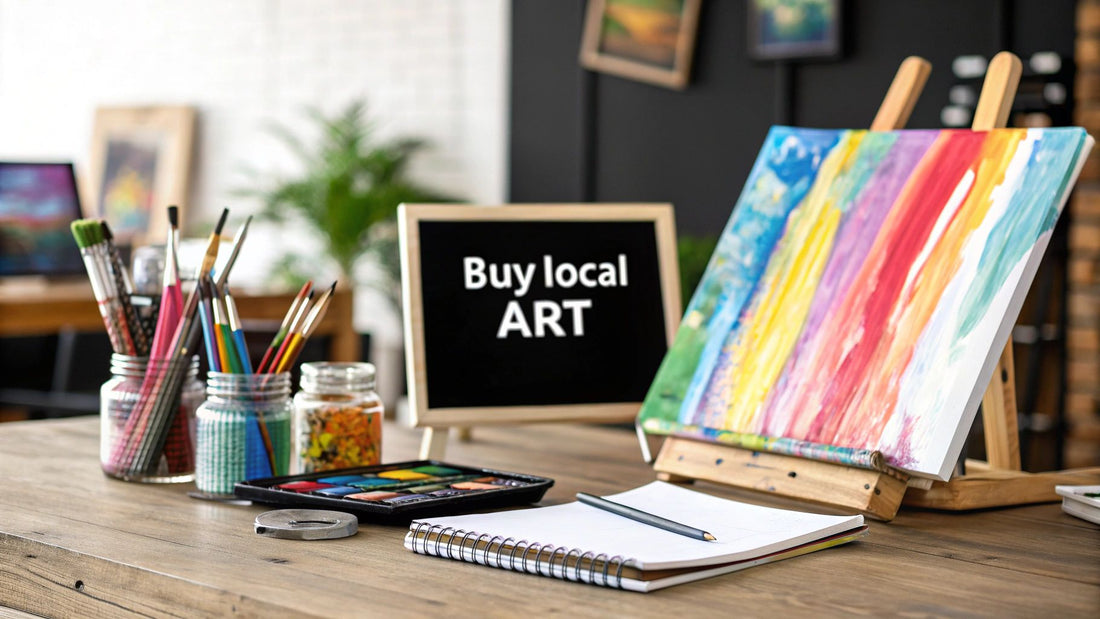So, you’re ready to bring some unique, meaningful art into your home? That’s fantastic. You can find incredible local art in all sorts of places—from the quiet, polished halls of traditional galleries to the buzzing energy of an art fair, sprawling online marketplaces, and even straight from the artists themselves. Each path offers a completely different adventure, whether you're looking for a highly curated masterpiece or a personal, commissioned piece.
Why Buying Local Art Matters
Let’s be honest, choosing to buy local art is about so much more than just decorating an empty wall. It's a real investment in the creative heart of your own community.
When you buy a piece from a local artist, you're doing more than just getting something beautiful for your home. You're supporting a small business, championing a neighbor's dream, and weaving yourself into the cultural fabric of your city. It's a simple, direct way to help ensure that creativity keeps flourishing right where you live.
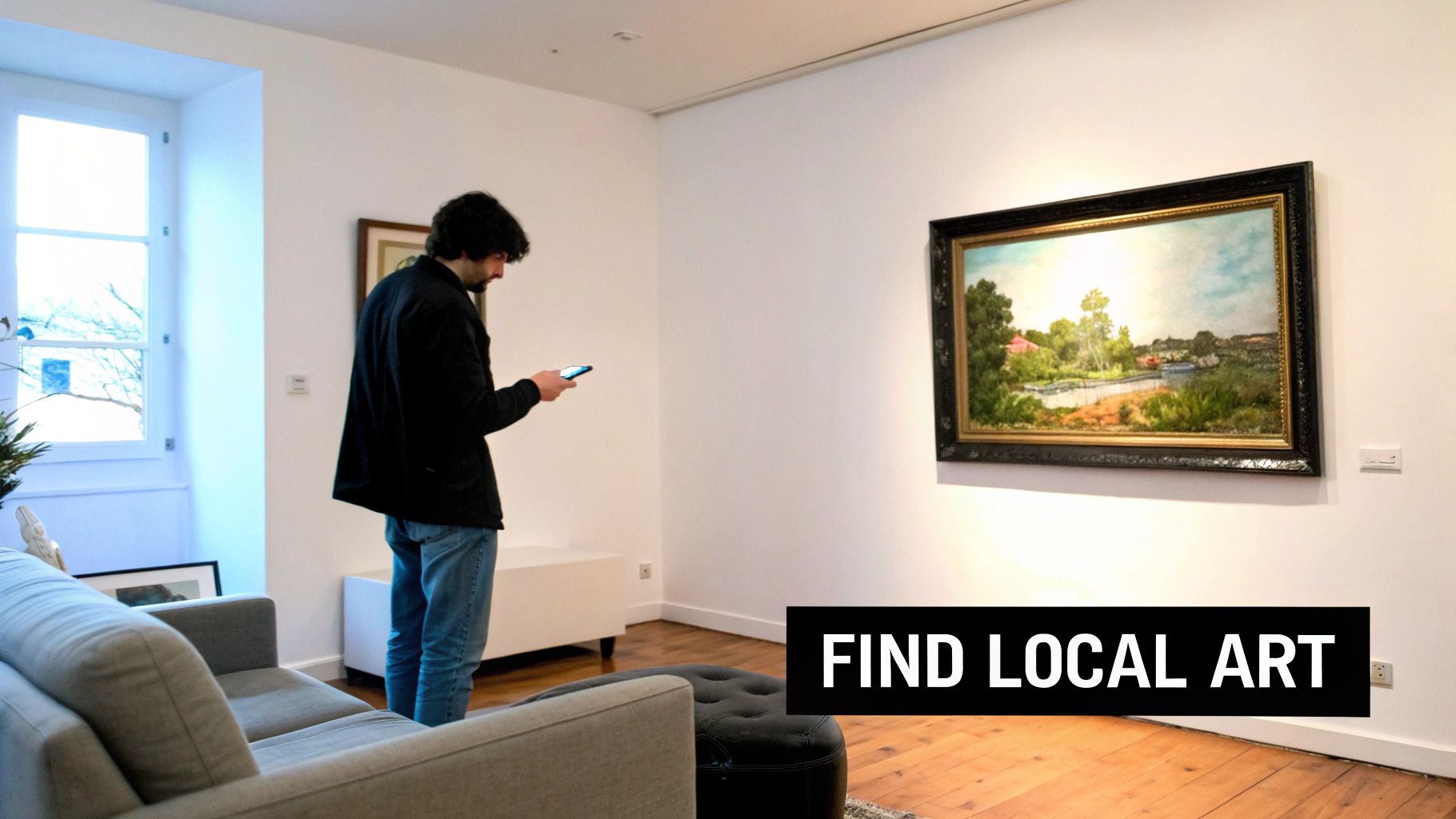
Think of this guide as your personal map to the local art scene. We'll walk through all the different avenues, helping you go from just admiring art to confidently making your first purchase. The goal is to find pieces that truly speak to you and your story.
Finding Your Path in the Art World
The journey to finding that perfect piece might seem a little intimidating, but it really just comes down to knowing where to look. Each place you can buy art offers a totally different vibe, catering to different tastes and budgets.
Here's a quick breakdown of the main spots:
- Art Galleries: These are carefully curated spaces, almost like a museum where everything is for sale. They’re perfect if you're looking for a vetted selection and want some expert guidance from the gallery staff.
- Art Fairs and Festivals: Picture a bustling, open-air market brimming with creativity. These events give you a huge variety of styles to explore and the incredible opportunity to chat with the artists face-to-face.
- Online Marketplaces: The internet brings the art world to your fingertips. Digital platforms offer convenience and an almost endless selection, letting you browse local talent from your couch.
- Direct from the Artist: This is the most personal route you can take. It opens the door for custom commissions and gives you a direct line to the person and the story behind the work.
By exploring these different options, you empower yourself to find art that not only enhances your space but also tells a story you want to be a part of. The connection you make is as valuable as the art itself.
To help you get your bearings, the table below gives you a quick snapshot of what to expect from each of these channels. It's a great starting point for figuring out where you want to begin your search.
Where to Buy Local Art: A Quick Comparison
This table provides a snapshot comparison of the most common places to find and purchase local art, helping you decide which avenue best suits your needs.
| Buying Channel | Best For | Price Range | Discovery Experience |
|---|---|---|---|
| Local Galleries | Curated selections and established artists | Mid-to-High | Guided and formal |
| Art Fairs/Festivals | Variety and meeting artists directly | Low-to-High | Spontaneous and social |
| Online Marketplaces | Broad selection and convenience | Low-to-Mid | Independent and search-driven |
| Direct from Artist | Personal connection and custom work | Varies Widely | Collaborative and unique |
Each of these avenues has its own charm. The "best" one really depends on what you're looking for—whether it's the thrill of discovery at a festival or the quiet contemplation of a gallery. We’ll dive deeper into each one to help you navigate them like a pro.
Exploring Galleries and Art Fairs
Walking into a formal art gallery can feel a bit like stepping into a library—quiet, serious, and maybe even a little intimidating. I get it. But it absolutely doesn’t have to be that way.
Think of a gallery not as a silent museum, but as your personal, expert guide into the local art scene. These spaces are run by people who are genuinely passionate about art, and their entire job is to discover talented artists and share that incredible work with you.
Galleries do the heavy lifting for you. They act as a trusted filter, vetting artists and guaranteeing a certain level of quality and professionalism. This curation means you can have peace of mind, knowing the pieces you see have been hand-picked for their artistic merit and originality. It’s a fantastic place to start if you’re looking for established names or the next big thing.
Making the Most of a Gallery Visit
The real secret to a great gallery experience? Just talk to people. Don't be shy—the gallery staff, or gallerists, are there to help. They can share the story behind a piece, explain an artist's technique, and offer insights you’d never get from simply looking.
Building a relationship with a gallerist can be a game-changer. Once they get a feel for your tastes, they can give you a heads-up when new artists come in that they think you’ll love.
To get the conversation flowing, try asking a few simple questions:
- Can you tell me a little more about this artist's background?
- What’s the story behind this particular series of works?
- Do you represent other artists with a similar style?
Approaching a gallery visit with curiosity turns it from a quiet walk-through into a fascinating learning experience. If you happen to be exploring a vibrant art hub, knowing the local landscape is everything. For example, our guide to French Quarter art galleries is a great starting point for discovering amazing local talent.
The best galleries do more than just sell art; they build genuine connections between artists and collectors. They become community hubs where stories are shared and new passions are discovered.
The Lively World of Art Fairs
If galleries are the curated boutiques of the art world, then art fairs are the bustling, high-energy festivals. Picture a massive, open space filled with dozens of booths, each one a mini-exhibit for a different artist or gallery. The atmosphere is social, exciting, and way less formal. It's a true one-stop shop where you can see an incredible variety of styles, mediums, and price points all in a single afternoon.
One of the best parts of an art fair or an open studio event is getting direct access to the creators themselves. You can actually meet the artists in person, hear them talk about their inspiration, and ask questions right on the spot. That personal connection adds a layer of meaning to a piece of art that’s hard to replicate anywhere else.
The way we find and buy local art is also shifting, blending these physical events with digital convenience. In 2024, digital art sales made up 17% of the global art market's turnover. What’s more, 43% of galleries plan to ramp up their online sales efforts. This means you can often browse an art fair's catalog online before you even go, making it easier than ever to connect with local creators from anywhere. You can explore more about the art market's strategic rebalancing on contemporaryartnow.com.
Your Art Fair Checklist
Let’s be honest, the sheer amount of art at a fair can be a little overwhelming. Going in with a loose plan helps you focus your energy and find pieces you really connect with.
- Do a Quick Lap First: Walk the entire space once without stopping for too long. Get a feel for the layout and make a mental note of which booths you absolutely want to circle back to.
- Set a Budget: Decide on a price range before you arrive. It’s easy to get swept up in the excitement, but having a budget helps you shop with confidence.
- Talk to the Artists: Seriously, don't hesitate to chat with the artists. Ask them about their process, their inspiration, their story. It’s what they are there for!
- Take Business Cards: Not ready to buy on the spot? No problem. Grab a card or a flyer so you can follow up later or check out their work online.
Whether you prefer the quiet, thoughtful vibe of a gallery or the lively buzz of a fair, both are fantastic ways to discover local art that truly speaks to you.
Navigating the Digital Art Marketplace
The internet has completely changed the game for art lovers. Suddenly, your laptop or phone is a doorway to a global gallery, making the question less about if you can find local art online and more about where to even begin. With so many options out there, it really helps to know what you're looking at.
Think of it like shopping for clothes. You've got your massive department stores with a bit of everything, your carefully curated boutiques with a distinct point of view, and your independent designer pop-ups. The online art world works in much the same way, with a different kind of experience for every type of collector.
Types of Online Art Platforms
Once you start digging in, you'll see that most online art sellers fit into a few main categories. Each has its own vibe, whether you're after a massive selection, an expert-guided experience, or a more direct line to the artist themselves.
Here's a quick rundown of the big players you'll encounter:
- Curated Online Galleries: Platforms like Saatchi Art or Singulart operate a lot like their traditional brick-and-mortar cousins. They have teams of curators who scout artists and hand-pick the work, which means you can trust that everything has passed a quality check. It's a fantastic place to start if you want a more guided discovery process.
- Artist-Driven Marketplaces: Think of sites like Etsy or Artfinder as huge, open markets where artists set up their own digital storefronts. The variety is staggering, with everything from affordable prints to one-of-a-kind paintings.
- Social Media Sales: Don't sleep on platforms like Instagram and Facebook. Many artists now sell directly to their audience through posts, stories, and DMs. This is probably the most personal and immediate way to buy a piece of art.
The global art market is showing a really interesting shift. In 2024, even though total sales took a dip, the actual number of transactions went up by 3% to 40.5 million. This tells us there's a huge boom in the more accessible, affordable corners of the market—exactly the kind of art you'll find on these online platforms. You can explore more about recent art market trends on prominentpainting.com.
Curated Galleries Versus Open Marketplaces
So, should you go with a curated gallery or an open marketplace? It really just boils down to what you're looking for in the experience. A curated site gives you a sense of security and prestige, kind of like shopping at a high-end boutique where you know everything has been carefully selected.
Take a look at the Saatchi Art homepage, a perfect example of a major curated gallery.
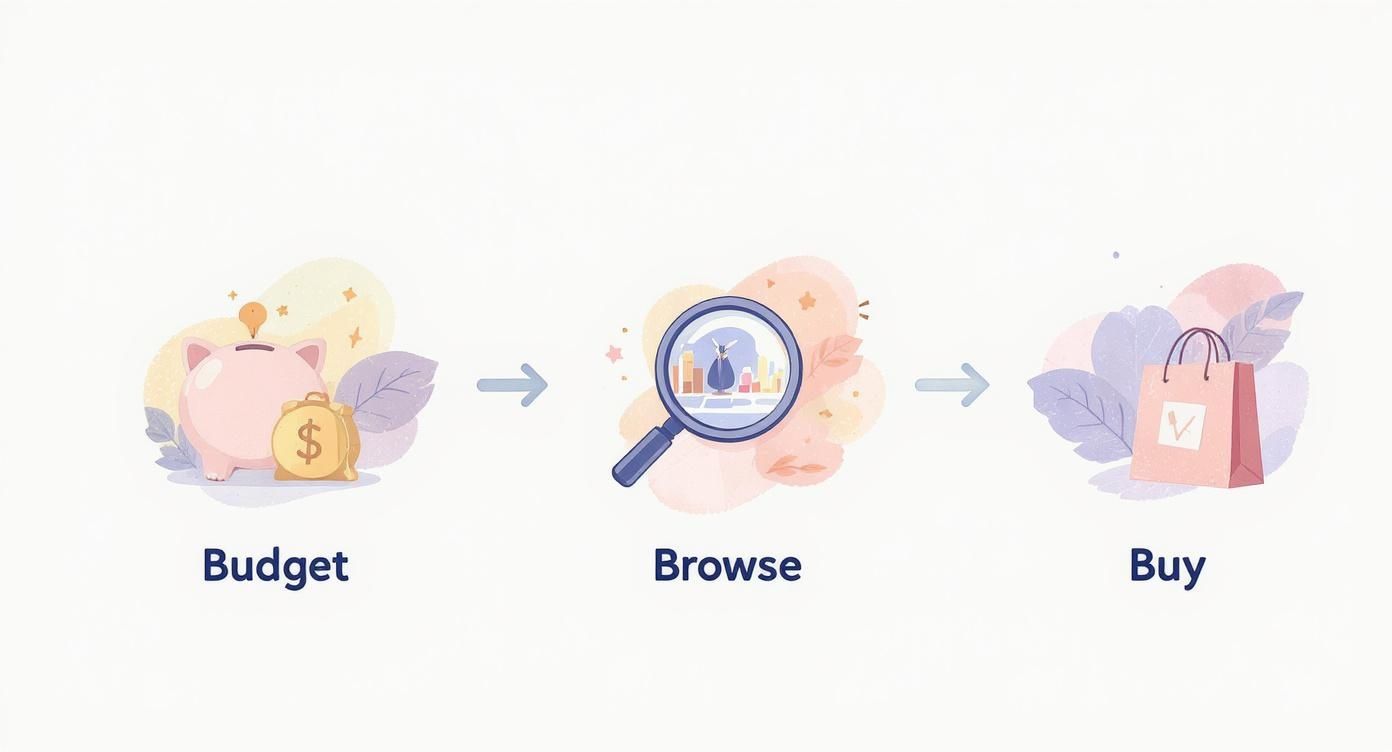
Right away, you see highlighted collections and featured artists. They're guiding you toward work that's already been professionally vetted, which can be a huge relief.
On the other hand, an open marketplace like Etsy feels more like a sprawling, vibrant bazaar. It’s less filtered, so you’ll have to do a bit more digging yourself. But the thrill of sifting through it all to find that one hidden gem from an emerging artist is part of the fun.
Buying art online is an act of trust. Whether you choose a curated site for its vetted quality or an open marketplace for its direct artist connection, the key is to feel confident in your purchase and connected to the work.
No matter where you're buying, the fundamental steps are pretty much the same. You find something that speaks to you, you make sure it fits your space and budget, and you bring it home.
The most important thing is to approach it with intention. Know what you're looking for, enjoy the process of discovery, and be ready to pounce when you find a piece you can't live without.
A Guide to Buying Art Safely Online
The convenience of buying art from your couch is amazing, but it pays to be a little cautious to make sure everything goes smoothly. Protecting yourself is simple once you know what to look for.
Here’s a quick checklist to help you buy with total confidence:
- Verify the Artist’s Authenticity: Do a quick bit of homework. Look up the artist’s official website, social media pages, or any articles they might be featured in. A consistent online presence is usually a great sign you're dealing with a pro.
- Read Reviews and Testimonials: See what other buyers are saying! Reviews on the marketplace itself, on Google, or on the artist's website can tell you a lot about their reliability and the quality of their work.
- Understand the Fine Print: Before you hit that "buy" button, get clear on the details. Read the shipping policies, check out the return options, and make sure the artwork is insured while it's on its way to you.
- Use Digital Visualization Tools: This is a game-changer. Many galleries and artists now have "view in room" features that use your phone's camera to show you what a piece will look like on your actual wall. It’s a fantastic way to get a feel for the scale and style before you commit.
Follow these simple steps, and you'll be able to navigate the digital art world like a seasoned collector and find that perfect piece to make your home feel more like you.
How to Buy Directly From an Artist
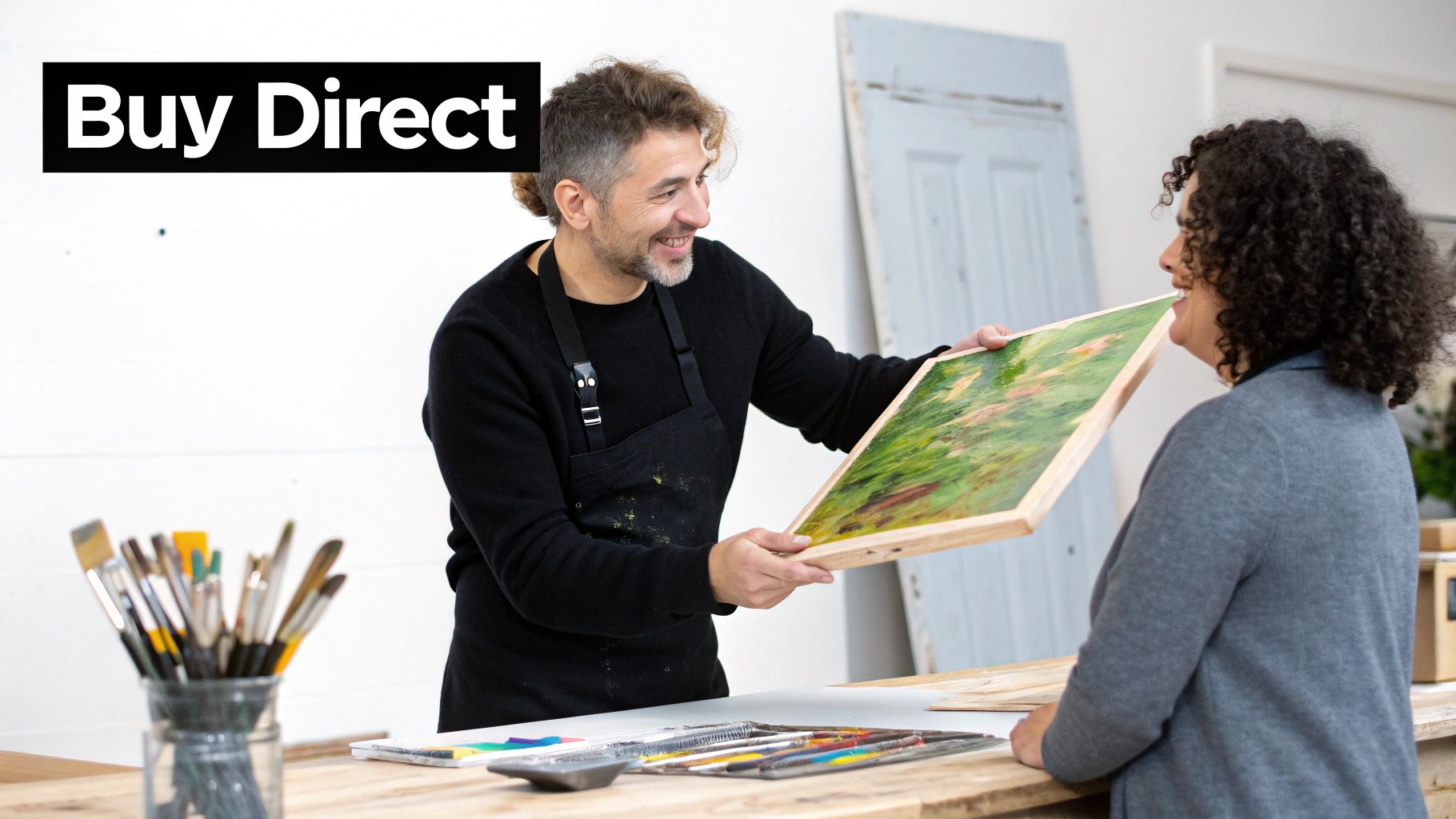
There’s a special kind of magic in connecting directly with the person who created a piece of art you love. Buying from an artist is so much more than a simple transaction; it’s like getting an invitation into their creative world. This approach turns the hunt for local art into a personal and deeply satisfying experience.
Honestly, it's one of the best ways to go. By engaging directly with the artist, you're essentially using the direct-to-consumer (DTC) model, cutting out the middlemen like galleries. The result? A much closer connection to the work, and often, a more accessible price. You’re not paying for the gallery commission, which can be a hefty markup.
Plus, this approach ensures more of your money goes straight into the artist's pocket, directly funding their next creation and helping them build a sustainable career. It’s a powerful way to vote with your wallet for the local creative scene.
Finding and Connecting with Artists
So, how do you find these talented folks? It’s probably easier than you think. A lot of professional artists have their own websites that serve as a digital portfolio and a storefront, making it super simple to browse what they have and make a purchase.
Social media is another goldmine. Platforms like Instagram have become virtual galleries where artists share their latest pieces, show behind-the-scenes works in progress, and offer a peek into their studio life. Following artists you admire is a fantastic way to discover new work and be the first to know when something you love becomes available.
A great tip for finding local talent is to search for hashtags related to your city's art scene, like #NewOrleansArtist or #AustinArt. Don't forget about open studio tours and local art walks, either—they're amazing opportunities to meet artists in their element and see where the magic happens. For a great example of an artist connecting directly with collectors, check out the work of this talented local New Orleans artist whose pieces beautifully capture the city's unique spirit.
The Art of Commissioning a Custom Piece
Have you ever dreamed of owning a piece of art made just for you? Commissioning a work is a really cool collaborative journey that brings your personal vision to life. Think of it as an exciting partnership between you and the artist.
It might sound intimidating, but the process is usually pretty straightforward. It all kicks off with a conversation where you'll discuss your ideas, the size you're thinking of, your color palette, and any specific subjects you have in mind. A good artist will help guide you, translating your vision into a solid plan.
Commissioning art is the ultimate form of personalization. It’s a co-creative process that results in a piece that is not only beautiful but also holds a deep, personal meaning that can never be replicated.
To make sure everything goes smoothly, it’s smart to set clear expectations right from the start. This is where a simple agreement or contract comes in handy.
A typical commission contract will cover:
- The Scope of Work: A detailed description of the final piece.
- The Timeline: A rough schedule for completion, maybe with a few key milestones.
- The Cost and Payment Structure: The total price and how it will be paid (often 50% upfront and 50% on completion).
- Revision Policy: An understanding of how many, if any, adjustments are included.
This simple step protects both you and the artist, makes sure you're on the same page, and keeps the whole experience positive and professional.
Studio Visit and Contact Etiquette
When you decide to reach out to an artist or arrange a visit to their studio, a little bit of etiquette can make all the difference. Just remember, their studio is their workspace, so it's always best to be respectful of their time and creative process.
If you’re sending an email or a DM, keep your first message friendly, concise, and clear. Introduce yourself, mention which of their works caught your eye, and explain why you're getting in touch—whether it’s about a specific piece or a potential commission.
And for a studio visit, always schedule an appointment in advance. Please don't just show up! Arrive on time, come prepared with a few questions, and just be genuinely curious about their work. Artists are usually incredibly passionate about what they do and are happy to share their stories with someone who’s truly interested. That personal connection is what makes buying art right from the source so special.
Unexpected Places to Discover Local Art
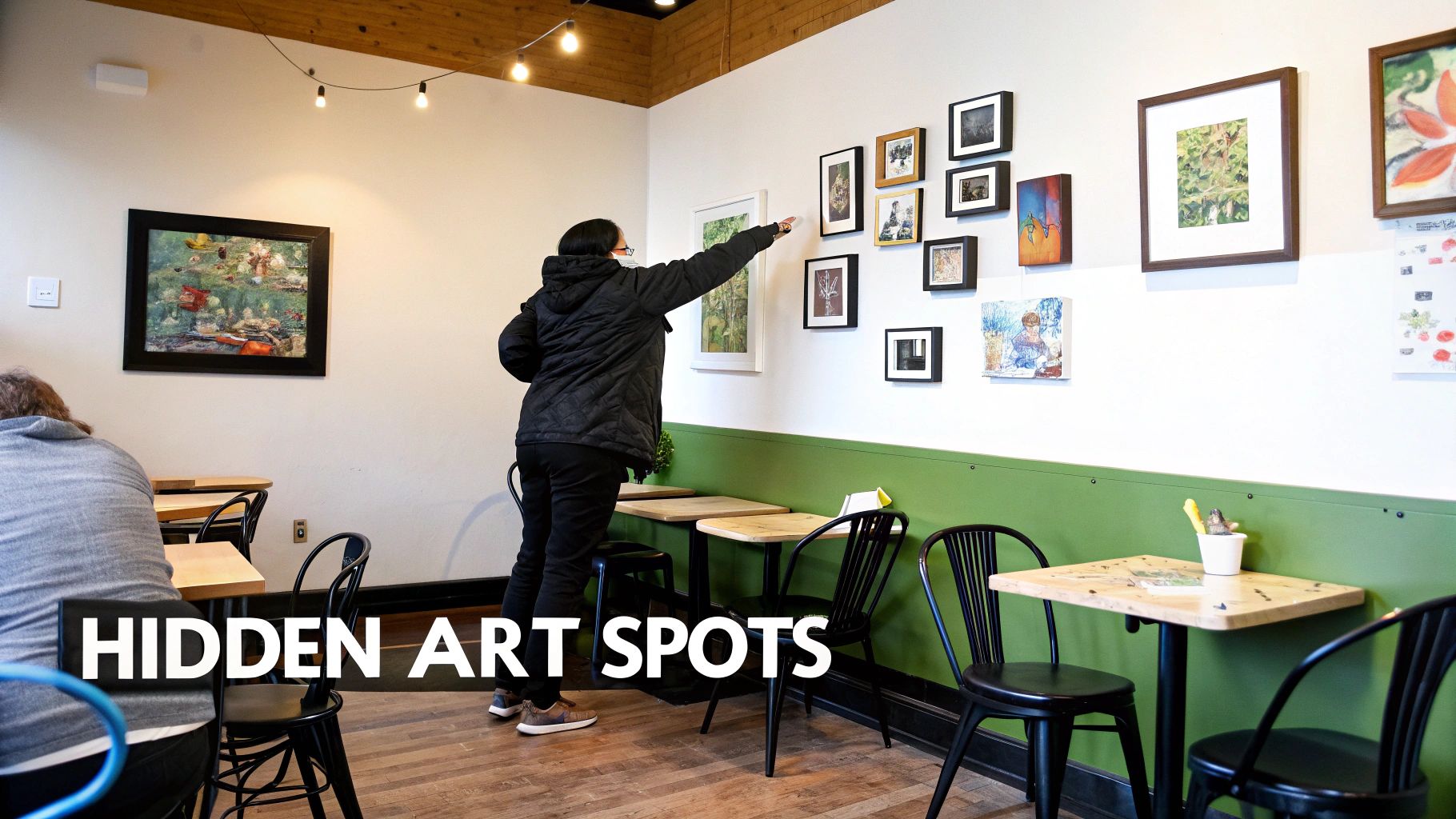
Sometimes the best art finds happen where you least expect them. While galleries and art fairs are obvious go-tos, some of the most exciting local art is hiding in plain sight—hanging on the walls of the places you already frequent.
Think about that cool painting you saw at your favorite coffee shop or the sculptures that caught your eye in a boutique hotel lobby. Businesses love partnering with local artists to liven up their spaces, which creates a wonderfully relaxed, no-pressure environment for you to browse. You can sip a latte and really spend time with a piece, making the whole experience feel more organic.
It's a true win-win situation. The business gets a beautiful, rotating gallery of decor, the artist gets seen by a whole new audience, and you might just stumble upon your next favorite piece. This is how art gets woven into the fabric of a community.
Training Your Eye for Everyday Art
Once you start looking, you’ll see art everywhere. The trick is to start thinking of your daily errands or a night out as a potential art-hunting trip. You just have to keep your eyes peeled for those creative gems.
You'd be surprised where you'll find these partnerships:
- Cafes and Coffee Shops: Many feature a "resident artist" for a month, dedicating wall space to their work.
- Restaurants and Bars: Higher-end spots often use original art to boost their ambiance and create a memorable vibe.
- Boutique Hotels: These places pride themselves on local flavor, and that absolutely includes decorating their lobbies, hallways, and rooms with art from the area.
- High-End Furniture Stores: They use original art to stage their showrooms, and more often than not, the art is for sale right alongside the furniture.
- Co-working Spaces: Creative hubs and shared offices are always looking to inspire their members, and displaying local art is a perfect way to do it.
And for those who love a good vintage find, don't forget to check out local antique stores. They can be an absolute goldmine for older paintings, prints, and unique decorative pieces from regional artists of a past era.
Art isn't confined to white walls and silent rooms. It lives and breathes in the heart of our communities, waiting to be discovered in the spaces where we connect, work, and relax.
How to Inquire About a Piece You Love
Spotted something you absolutely love? Don't hesitate to ask about it. The process is almost always straightforward.
First, look for a small label or placard next to the artwork. It will usually have the artist’s name, the title of the piece, and the price.
If you don't see one, just ask an employee at the counter or front desk. They'll have a price list or the artist's contact info handy. Most of the time, you can buy the piece right then and there, though you might have to wait until the end of its display period to take it home. A simple question is all it takes to make a great connection and bring home a piece of your community.
Got Questions About Buying Local Art? We've Got Answers.
Jumping into the world of art collecting is a thrill, but let's be honest, it can also bring up a few questions. This is totally normal. Think of this as your personal cheat sheet for navigating those common "what ifs" and "how tos" that every new buyer thinks about.
We'll clear up the mystery behind pricing and show you how to start a collection you love, even if you're not a millionaire. Consider this your final boost of confidence before you go out and find that piece that just clicks.
How Do Artists Price Their Work, Anyway?
Figuring out the price of a piece of art can feel like trying to solve a puzzle, but there’s a real method to it. It’s not just a random number! An artist is balancing a few practical things. They have to consider their time, the cost of their materials (good paint and canvas aren't cheap!), and of course, the size and intricacy of the artwork itself.
Then, there's the artist's own story. Their experience and reputation are a big part of the equation. An up-and-coming artist is likely going to have lower prices than someone who's been showing in galleries for decades and has a long list of collectors.
Here’s a quick look at what’s factored into that final price:
- The Artist's Journey: Are they an emerging talent, mid-career, or a well-established name?
- Size & Materials: Bigger pieces or art made with expensive media naturally cost more.
- Time & Effort: How many hours and how much detail did it take to create? A highly detailed piece takes a lot more time than a simple sketch.
- Track Record: What have similar pieces sold for in the past? This helps set a consistent value.
Can I Really Start Collecting Art on a Budget?
Yes! One hundred percent, yes. Let’s bust this myth right now: you do not need a massive bank account to become an art collector. So many incredible local artists offer work that’s perfect for someone just starting out.
A great place to begin is with smaller original pieces. Think sketches, studies, or smaller paintings, which are usually much more affordable than the artist's huge, show-stopping works. Another fantastic route is to look at high-quality prints. Limited edition prints are often signed and numbered by the artist, giving you a collectible piece without the high price tag. It's not uncommon to find amazing prints for under $100.
Starting small isn’t just about the money—it’s about learning what you love and building your confidence as a collector. Your first piece is the start of your story, no matter what you paid for it.
How Do I Know If I'm Making a "Good Investment"?
It's tempting to think about art as a financial investment, and sure, some pieces do go up in value over time. But for your first few purchases, I’d encourage you to think about it differently. The absolute number one rule is to buy what you love.
Here’s why: the real return on your investment is the joy it brings you every single day. You're the one who's going to live with it, see it over your morning coffee, and have it as the backdrop to your life. If a piece of art makes you happy or makes your home feel more you, then it's already a priceless investment. When you focus on that personal connection instead of a potential price tag down the road, you'll always make the right choice.
Ready to find a piece that truly speaks to you? Dive into the incredible collections at William Tucker Art and bring home a unique work inspired by the raw beauty of nature and the soul of New Orleans. Discover your next treasure today.
